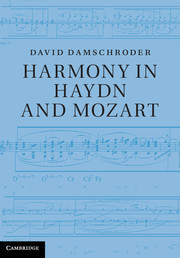Harmony in Haydn and Mozart
Langue : Anglais
Auteur : Damschroder David

Innovative analytical techniques provide a penetrating view of how Haydn and Mozart employ harmony in their compositions.
Integrating Schenkerian tools and an innovative approach to harmony, David Damschroder provides numerous penetrating analyses of works by Haydn and Mozart. A series of introductory chapters assist readers in developing their analytical capacity. Beginning with short excerpts from string quartets, the study proceeds by assessing the inner workings of twelve expositions from Haydn piano sonatas, six arias in G minor from Mozart operas, and three rondos in D major from piano concertos by Haydn and Mozart. In the Masterworks section that follows, Damschroder presents detailed analyses of six movements from symphonies, string quartets and opera by Haydn and Mozart, and compares his outcomes with those of other analysts, including Kofi Agawu, Robert O. Gjerdingen, James Hepokoski and Warren Darcy, Carl Schachter and James Webster. The book represents an important contribution to modern analytical discourse on a treasured body of music and an assessment of recent accomplishments within that realm.
Preface; Part I. Methodological Orientation: 1. Harmonic practice in the late eighteenth century: twelve excerpts from string quartets by Haydn and Mozart; 2. Anatomy of the I–II#–V two-part exposition: twelve keyboard sonatas by Haydn; 3. Composition in a minor key: six arias in G minor from operas by Mozart; 4. The happy ending: three sonata-rondos in D major from piano concertos by Haydn and Mozart; Part II. Masterpieces: 5. Haydn: Symphony No. 45 in F# Minor ('Farewell'), movement 2: in response to James Webster; 6. Haydn: String Quartet in G Minor (op. 20, no. 3), movement 3: in response to Robert O. Gjerdingen; 7. Mozart: String Quintet in C Major (K. 515), movement 1: in response to Kofi Agawu and Michael Spitzer; 8. Mozart: Don Giovanni (K. 527), Act I, Scene 13: Donna Anna's Recitative and Aria: in response to Carl Schachter; 9. Mozart: Symphony in G Minor (K. 550), movement 3, Trio: in response to Leonard B. Meyer; 10. Haydn: Symphony No. 96 in D Major ('Miracle'), movement 1: in response to Warren Darcy, James Hepokoski and Lauri Suurpää; Select bibliography; Index of works by Haydn and by Mozart; Index of names and concepts.
David Damschroder is Professor of Music Theory at the University of Minnesota. His current research focuses on harmony in tonal music, a project that began with a careful examination of historical analytical practices, the basis for his Thinking about Harmony: Historical Perspectives on Analysis (Cambridge University Press, 2008). The project continues with focused studies on selected repertoires: Harmony in Schubert (Cambridge University Press, 2010) and the present volume. Damschroder is the author of Music Theory from Zarlino to Schenker (1990) and his articles and reviews have appeared in many publications including Music Theory Spectrum, The Journal of Music Theory and Music Theory Online.
Date de parution : 08-2012
Ouvrage de 312 p.
17.8x24.6 cm
Date de parution : 06-2014
Ouvrage de 312 p.
17x24.4 cm
Thème de Harmony in Haydn and Mozart :
© 2024 LAVOISIER S.A.S.



